GUEST PLANETARY ASTROPHOTOGRAPHY ARCHIVE 1997-99
Last updated: 28 December 1999
GUEST PLANETARY ASTROPHOTOGRAPHY ARCHIVE 1997-99 |
Some ETX users have sent me examples of their astrophotography. If you have some examples you would like included here please send me a description of how you made the astrophotos and a copy of the images as GIF or JPEG files (due to internet email gateway issues, please send only one image file per message). Send to etx@me.com. Alternatively, if you have created your own web page with your examples please let me know and I'll include a link to your site.
| Thomas Stebler (steblerth@compuserve.com) |
|---|
 |
| The picture was taken the 12.22.1999, 20:45 - 20:47 UTC. Camera: cheap Mustek black and white internet camera without lens in the primary focus of my ETX. It is the average of 6 pictures and unsharp masking with Astroart version 1.5. It is interesting what you can get out of these cheap camera. Unfortunaltely the moons of jupiter are too weak in brightness. They cannot be seen on the picture. North is up, west is right. Greetings from Basel |
| Davide Favaro (dafavaro@tin.it) |
|---|
  |
| These are my first pictures of Jupiter and Saturn, taked with my excellent ETX 90/EC and my modified Quickcam Vc at the prime focus. Both are processed with Photo Styler and PaintShop pro. |
| Erwin Matys (erwin@matys.co.at) |
|---|
 |
| this is my first attempt to picture Jupiter with my ETX and the new Creative WEBCAM3. Poor seeing, but I couldn't resist. The image is a composit of the 10 best frames, processed with Photoshop. 1999-22-11 approx. 22:00 UT. If there is anybody else out there trying to use the WEBCAM3 with his/her ETX, I would like to communicate: erwin@matys.co.at |
| Michael L. Turney (mturney@innercite.com) |
|---|
 |
| With advice from Jim Berry I took a couple of Color QuickCam shots of Saturn last night. As most of you know Jim's pictures are the "standard" by which all photos should be measured. Well, though my picture of Saturn doesn't even come close to Jim's it was a fun first effort and am including it to demonstrate to first timers like me what's possible and to thank JIM. Camera was a modified Logitech Color QuickCam set in the eyepiece of the ETX-125EC without a barlow lens. |
| Joel Aron (frickin@earthlink.net) |
|---|
 |
| Here is another picture of Jupiter. I pushed the camera to it's limit on exposure, and nailed another single frame image! That camera is amazing. I just need a more stable viewing environment, and I'm in the ballpark for digital, end-user astrophotography. I feel this one is better than the one I gave you before....however, due to the extreme shutter speed (1/60 Second!!!!), and foolery of the exposure settings in the camera (iso800, +2.0exp), I was unable to capture any moons. (5 visible tonight). |
| Joel Aron (frickin@earthlink.net) |
|---|
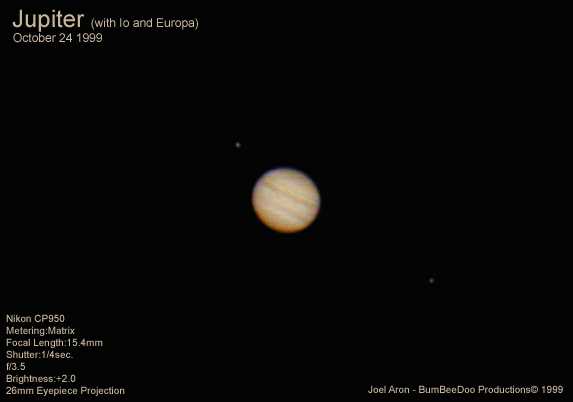
|
| My name is Joel Aron, and a proud owner of a new ETX125. Having the telescope for about a month, I've fallen in love with it, and just about spent every damn cent I own on getting my digital camera setup working correctly. Well...after finding this web site: www.wesley.net/cp950/Tmount/ I was able to get everything I needed in getting my Nikon CoolPix950 shooting right down into a TeleExtender at an eyepiece. I have yet to find a way to get the tripod from swaying/vibrating, but it's mostly because I'm on a wooden deck. Time for a field trip to the mountains. The Jupiter image was taken tonight, the night of the "Hunter Moon", October 24th. Jupiter was 15 degrees away from the Moon, and there's damn near no light pollution, but the Moon was glowing like a headlight. I used a 26mm eyepiece with a polar filter that was in a 2x Barlow. I removed the lens from the barlow so that I could just use the sleeve of the Barlow to push the eyepiece closer to where the lens of the camera. This is a single image, just as you see it, right out of the camera. I added a slight 'un-sharp mask' in Photoshop to help the contrast definition. For Saturn, I left the Barlow lens in place, and once again, a single image with even less of an 'un-sharp mask'. I hope that you'll be able to use these images, and if you do, please feel free to edit the above text to fit on your site. I hope that Meade does you right with all the help and service you provide! Please, keep up the great work! |
| PHILIPPE SUBRA (subramdza@arnet.com.ar) |
|---|
 
|
| I send you photos of Saturn and Jupiter I got yesterday night ( october 23rd) from Mendoza-Argentina. Yesterday, the sky was very steady. I had superb views in the eyepiece, so I decided to get my quickam VC, without its optic. Both photos are done with an eyepiece projection through a 15mm scopetronix eyepiece, mounted directly in an etx meade photo adaptator. These shots are not so precise as the ones of Jim Berry (congratulations Jim), but they are the result of one shot, eachone, even if I took some shots of each planet. Of course, these seem to me the best ones. I think that on the one of Saturn, one can see (or better, imagine) the cassini division. I regret that yesterday, at that time ( about 23.55, hour of Argentina), there was not the red spot. It will be for another time. I join, too a shot of Uranus, and one of mars I took at the beginning of october. Its only a curiosity, because I really prefer the ones of saturn and Jupiter. |
| Jim Berry (jim@emmgraphics.com) |
|---|

|
| I don't want to be dumping pictures on you all of the time, but I think you'll like these. You could either replace the ones that I gave you last time, or just add these to show how much better things can get with the same hardware, once you learn to use it. I'm going to put together a web page with all of this stuff, but haven't had a chance to get around to it yet. The first image is a time-lapse set of 3 shots of Jupiter, each made by taking 100 pictures and combining the best 70. I knew the Great Red Spot would be there, I was just lucky to catch Io. Other than the barlow, the hardware is exactly as before - plastic film can and all - pointed out the window. Image processing this time was done using custom software that I wrote myself (fancy Fourier filtering, mostly.) This second image is made from the best 40 of 75 shots of Saturn. I'm still not really able to get the Cassini division - but I'm working on it. I'll put the second image in another mail message, as you requested. |
| Jim Berry (jim@emmgraphics.com) |
|---|
 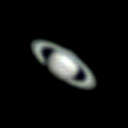 |
| Thanks for the terrific web site. I thought you might be interested in these 2 images that I took last night - Sept 18, 1999. They are my second attempt at using a modified Color QuickCam at the prime focus of my ETX-90/EC. I'm pretty pleased so far. The camera is a Color QuickCam with the lens and filter removed and the ball duct-taped back together and superglued to an old film canister with the bottom cut off. Pretty low tech, but it works. The images are the result of taking about 50 frames of each target out of my office window, subtracting a dark frame, and then putting them in order of sharpest to fuzziest. The best 10 (Saturn) or 15 (Jupiter) shots are then averaged together and the resulting images are color balanced and unsharp masked. I can be reached at jim@emmgraphics.com if anyone is interested in more details. |
| "Nick" Michael Martinides (michael.martinides@siemens.at) |
|---|

|
| I live in Vienna / Austria and light-pollution is a major problem as it is in most larger cities. But on 12th Sept. the conditions for photographing the planets werde phantastic: the air was extremely stady and the views of Jupiter and Saturn were crisp as never before. I used eyepiece-projection on my ETX-90/EC with a Meade 9.7mm and I took several photos with the Pentax-camera attached to the modified #64-adapter. The first picture shows Jupiter and his four moons (800 ASA, 10 sec) and Jupiter (1 sec). The second picture shows Saturn with a lot of details (3 sec): the planet with two bands, the shadow of the planet on the rings and the cassini-division (!). All pictures were scanned from the photos and enhanced with CorelPhotoPaint7. On that evening the view of Saturn was so crisp, you could see the cassini-division on the whole ring (not only on the edges as usual). If anybody is interested on further details he/she can contact me by e-mail: michael.martinides@siemens.at or visit my homepage http://mitglied.tripod.de/Nick9000/etx/etx.html (german language), there are further pictures from the moon and from the eclipse'99. |
| Liem Bahneman (roland@cobaltgroup.com) |
|---|
 |
| 2 images stacked and unsharp-masked. Image acquired with a Color Quickcam and a 2x barlow (quickcam optics were removed to expose bare CCD). |
| Arne Tjolsen (arne.tjolsen@pki.uib.no) |
|---|
| On my pages I have collected some photos I've taken through the ETX this
spring. http://www.uib.no/people/mfyat/astro/astroimages.html |
| Dan Hawrylkiw (dan.g.hawrylkiw@intel.com) |
|---|
 |
| This image of mars was taken from Chandler, AZ on 4-17-99 using an Afocal configuration with an Olympus D620-L digital camera. The effective focal length was 3600mm. The camera was handheld and the exposure was set down 2 stops. Two frames were merged and unsharp masked in Photoshop to give the resulting image. Both camera and scope fit in the ETX travel bag - portable astrophotography made easy.... |
| Philippe Subra (subramdza@arnet.com.ar) |
|---|
   |
| I send you some photos I Have recently taken with my Etx. All were taken with a Quickcam VC without objective, directly in the short 2x meade Barlow. I am french living in Mendoza, Rep. of Argentina, where I took these photos: Saturn, early february, I don't remember exactly the date. Mars during the night of march 13th. I must say I found verye difficult first to find the planet to focus in the small chip, and then to focus correctly. I never reached to have as much details as seeing directly wih my eyes through the eyepiece. so the result is that. I am really sorry for my so bad english. Very best regards, and congratulations for your fantastic site . |
| Daniel Beringer (ustirna@idl.net.au) |
|---|
 |
| Picture of saturn that I took through my etx. I took the image on the 28:12:98 using a 10mm lens for eyepiece projection, 3200iso Konica film and a exposure time of 5 seconds. |
| VincentJean-Victor (Jeanvictor.M.V@wanadoo.fr) |
|---|
 |
| Blake (blaket@logicsouth.net) |
|---|
 |
| As everyone else has said, thanks for your hard work in maintaining this website. As a new ETX owner (actually just returned and awaiting my new ETX-90) your resources have been inspiring. After viewing the digital photos I was blown away when I saw that someone was able to take pictures with a Sony Mavica held to eyepiece of ETX. I tried it and below is my first attempt. Jupiter Shot taken at 9:30 PM Dec 29th. 9.7mm plossel, with Sony Mavica camera somewhere between 6X and 9X. (guestimate). |
| Joe (joe@supply.com) |
|---|
 |
| This image was made on 1/12/99 with my ETX and a Kodack DC260. The image was obtained using through the eyepeice photography with the camera mounted on a tripod. Only the contrast has been adjusted. f/3 1/30sec +2.0 EV. |
| Dave Stone (david_stone@cca-int.com) |
|---|
 |
| Here's a picture taken through the ETX using a pro Video CVC-243CS B&W CCD camera. The camera is almost exactly the same size and shape as a standard eyepiece (and a piece of electrical tape makes it a perfect fit). The camera is mounted in a 2X barlow for this shot and placed in the main eyepiece holder. Output from the camera is to Hi-8 video tape. Image capture is via a PC with Matrox Rainbow Runner Studio and Ulead Media Studio Pro video editting software. I recorded about 2 minutes of video including sections where I held RGB filters in front of the scope lens (this is the poor man's method of trying to generate 3 color images to composite). The filters I'm using are high quality gels but not photgraphic quality, 90% color saturation (3 full F-stop reduction for filtered colors). The blue and green filters distorted the image far too much, but the red filter generated a very nice image. I'll be using 30% photographic quality filters in the future. The image on the left is the actual image unretouched. The image on the right is a blowup, contrast enhanced and sharpened using Adobe PhotoDeluxe. |
| Han Kleijn (Han_Kleijn@compuserve.com) |
|---|
 |
| Here is the latest Saturn picture made with my ETX and the PC video camera the "Blaster Webcam II". I'm very satified with the result. It is much easier to use a camera directly connected to the PC, than shooting a film and wait a few days for the development. The shot was made through an open window of my house, close to my heavy tower model computer. (In fact the ETX was standing half outside window frame) It was freezing cold, a few degrees below zero and the temperature in the room was about zero. The sky was very clear and due to the equilibrium between the room and the outside air temperature, the conditions where very good. Only the intensity of the picture has been adjusted. Nothing else. For more Webcam II pictures see: ourworld.compuserve.com/homepages/han_kleijn/webcam.htm. |
| Bernard Allouche (geomatiq@certu.fr) |
|---|
 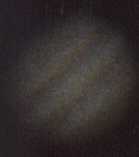 
|
| Please find here my "best-of" made this sommer from my flat in Lyon (France). I used Paint Shop Pro for assembling, and enhancement (contrast, addition of jupiter1 and jupiter2 to obtain jupiter3, etc). Slide 1600 Fuji for Jupiter and Saturn. Jupiter1 : F : 12000mm and 1/4s. Jupiter 2 F:12000mm and 1/8 s. Jupiter 3 = Jupiter 1 + Jupiter 2. Saturne = 12000mm 2s (trail...). Thanks for your site and sorry for my bad english. If you need, please mail me at this adress : geomatiq@certu.fr , with the mention "A l'attention de Bernard Allouche" |
| Peter (prc@riskconsulting.com) |
|---|
 |
| Here is composite image of Jupiter and (from left to right) Io, Europa and Ganymede taken with my ETX and a modified B&W Quickcam . Two frames (one of Jupiter and one of the moons) were combined using Paint Shop Pro since different exposure settings were needed to capture each image. The ETX was mounted on the new ETX Field Tripod and my DewBlocker dew cap blocked the stray light from a neighbor's deck. More of my images can be found at: http://www.riskconsulting.com/astroimg.htm. |
| Tom Alderweireldt (Tom.Alderweireldt@ping.be) |
|---|
| I just managed to capture a pretty decent Saturn image with my ETX and Pixcel255 CCD-camera. The image is a sum of 30 exposures of 0.04 seconds, digitally enhanced by unsharp masking. I did not believe an ETX could do this, it is on the limit of seeing the Cassini division in the rings. The somewhat mottled appearance is due to the unsharp masking technique which also enhances the noise in the image. The ETX was standing on a table, with its clockdrive activated. A 3x teleconverter was used to extend the focal length to F/42 (3750 mm). The seeing was not so good, images taken between clouds. See my ETX page at www.ping.be/~pin01622/ETX.HTML.
Tom Alderweireldt |
| Bruno Najac (sfe@magic.fr) |
|---|
 |
| On the attached picture one can guess at Jupiter's G.R.S. (better sight at print size). It is a composite of 4 pictures taken with my etx in Paris the 16th of October 1998 every 30 sec. from 22H40 UT. 3 sec. exposure each; magnification 370x; Fuji G800; Nikon F3. |
| Joan Vidal Llid (Vidalm@ctv.es) |
|---|
 |
| I am an ETX owner from Spain. Venus. Kodak gold 200Asa Color print film. 12,4mm eypiece, 2 secons. |
| Liem Bahneman (roland@cobaltgroup.com) |
|---|
| http://asteroid.org/liem/gif/101598/index.html
These were taken with a regular b/w quickcam at the prime-focus (the butt-end of the scope, not the eyepiece part). I had to make an enclosure for the cam with a party-favor-size play-doh can and the plastic cover for one of them gumball machine cases ;) Seems to work pretty well! |
| Bill Hardin (bhardin@bellarmine.edu) |
|---|
 |
| I've got some new stuff. Pictures of Saturn and some better pictures of Jupiter. I had a particularly clear night and that helped. I am still limited by the video capture at Bellarmine (my college.) I actually have shots with Jupiter's moons but the video capture didn't get them. |
| Bill Hardin (bhardin@bellarmine.edu) |
|---|
|
|
| Here are some stills from a video that Bill did of Jupiter. He notes: While taping it, I said to myself: "standard orbit Mr. Sulu - Aye Captain!" You can see a video of the moon and a diagram of his setup on the Guest Astrophotography - The Moon page (QuickTime 3.0 required). |
| Pat Knoll (pknoll@prodigy.net) |
|---|
 |
| I thought you might like a composite photo taken with a quickcam and ETX. The photos were taken 09/13/98. Ganymede Io Jupiter Europa Callisto is the sequence. Three photos were combined using Corell PhotoPaint. The sky was pretty light polluted as usual here in San Diego. The standard Quickcam Software was used on a laptop to control the camera. |
| Bruno Najac (sfe@magic.fr) |
|---|
  |
| Here is a composite picture taken with my etx on my balcony in Paris. Film is Fuji 800; camera Nikon F3; ep. 6.7 mm uwa; Meade variable teleconverter at full extension (117 mm); magnification about 370x; "hat trick" method. Exposure time : Jupiter 3 s. ; Saturn 12 s. Minolta QS 35+ film scanner; Photoshop contrast enhancement. But due to time exposure (12 s. for Saturn), I had to make severe modifications to insure correct tracking. First I made the Han Kleijn's variable speed modification but I set an external potentiometer. So depending on the planet to photography, the speed can be exactly adjusted to it. Second I noticed that in some cases batteries are not powerful enough to move rather heavy camera when ota has to climb. So I mounted an external power supply. On the attached picture you can see from right to left: - the speed adjustment potentiometer, - the push button which temporarily gives full tension to motor, - the jack inlet to plug in the external power supply. Thanks for your great site - Bruno Najac |
| Al Peck (PEKTRONICS@aol.com) |
|---|

|
| Here are some shots taken with a homemade CCD. A little bit about the conditions...NOT GOOD. Here in So. Calif. we are in the middle of a real heat wave, and heat distortion is very bad. Like looking thru two feet of moving water. VERY surprised at how well these shots turned out. Also keep in mind that the CCD chip is very small (about 1\2"" square) so only a small area of the projected image is on the chip. This magnifies everything immensely including distortion. Can't wait for this winter and the atmosphere to calm down a bit.. should get much better pix. Find the two moons europa & ganymede on the Jupiter shot (upper left and lower right). Note the Jupiiter bands..... not bad eh! Some details of the homemade CCD are on the Guest Contributions page. |
| Corrado Pido' (corra@ossola.it) |
|---|
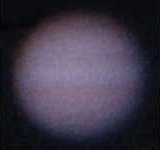 |
| Jupiter photo made with my PHANTASTIC MEADE ETX in mountain at 1200 meters with 7,5 mm Superplossl Eyepiece in projection, using Telextender, yashica fx3 2000 and Kodak Color film at 1000 ASA for 2,5 exposure time. |
| Steve Myers (myersj@tidalwave.net) |
|---|
   |
| Here are some Connectix Color Quickcam images of Jupiter and Saturn from 12 Jul 98. I used the 26mm eyepiece and with Color Filters #82A + 8 (Light Blue + Light Yellow). I captured the images with Connectix Quickmovie (with the 2X Zoom engaged) while I performed fine focus adjustments. Then, I went through the resulting AVI file and copied the best frames to Microsoft Photo Editor. Then I cropped and enlarged the images. |
| Kit-ying Hui (khui@csd.abdn.ac.uk) |
|---|
 |
| Thanks for the info. on your ETX page. After reading the experience of others, I finally purchased a color QuickCam 2 and tried taking photos with the ETX. The larger image was taken at 166x with the Meade 4000 15mm Plossl and the 2x barlow. For the smaller one, I don't quite remember the exact magnification (Sorry! :-) It was taken without the barlow, anyway. I'm using eye-piece projection by attaching the QuickCam to the eye-piece with a piece of adhesive tape. The Meade 4000 series has a rubber eye-cap so this makes it easy. |
| Han Kleijn (Han_Kleijn@compuserve.com) |
|---|
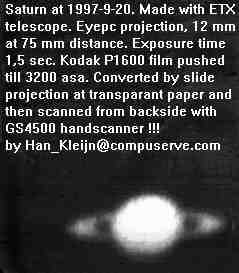 |
| This was made with my ETX telescope. On the slide it was looking pretty good. So was thinking of transfering it to a photo cd. However due to the fact that I made only a few pictures in the last months, it would be a little expensive. So I found another way to convert the slide to a file. For this I used my slide projector and a simple handscanner. First the slide was projected at a distance of a few meters on a piece of transparant paper (taped on glass) and then the image on the backside was scanned with my very simple GS4500 handscanner. It works fine with high contrast pictures. |
| Paul S. Walsh (filmdos@seanet.com) | |
|---|---|
 |
|
| Any shortcomings in this picture are due to my shivering hands or the Casio. Saturn looked GREAT through the ETX. I must say, though, I think I'm starting to get the hang of this EP Projection routine. The main discovery for me was being careful NOT to touch the eyepiece with the Casio at all whereas, before, I was using my index finger to line it up and that was scrambling the shot. I also just discovered what a little brightness and contrast control can do using Paint Shop Pro. Just those items make a world of difference. I believe Paint Shop Pro still offers a free demo at http://www.jasc.com. | |
| Ray Wartinger (Ray_Wartinger@wb.xerox.com) | |
|---|---|
 |
|
| Image of Saturn-Moon near-occultation taken on November 11 from Rochester, NY. ETX direct projection using miniature CCD video camera and Snappy screen capture. Some minor tweaking of image using PhotoStyler. | |
| Michael Rochfort (michael@netro.com.au) | |
|---|---|
 |
 |
| Jupiter (left) with 4 moons visible, at about 0:30 am AEST (Australian Eastern Standard Time) on September 7th, 1997. This image is a small portion of one taken at the prime focus of the ETX using Fuji HG1600 print film. Exposure was 1/4 second. Visible from left to right are Callisto, Io and Europa involved in a mutual event (appearing as one) and Ganymeade. This view approximates the view through the ETX with the 26mm eyepiece, except that bands are visible on the planet itself, which is over-exposed in this image in order to record the moons. Jupiter (right) by eyepiece projection - using the Meade ETX and variable projection camera adapter with 9.7mm Meade Super Plossl eyepiece and a Nikkormat EL camera. Exposure was 2 seconds on Fuji HG1600 with the drive running on the ETX. Light pollution was moderate and seeing less than steady. This is approximately the size of the image using a 6mm eyepiece with the ETX, although the visual image through the telescope is much sharper. [See Rochfort's www.netro.com.au/~michael/astro/astro.htm web page.] |
|
| Lawrence A. Ciscon (lciscon@capsela.modulus.com) | |
|---|---|
 |
 |
| I played with enhancing these a bit in Paint Shop Pro 4, but I may have actually damaged them more than helped them. The over-exposed Jupiter with its moons is with the standard ETX lens and a barlow. The higher mag Jupiter is with a 180x eyepiece. [See the ETX Guest Contributions page for how Lawrence mounted the QuickCam to the ETX.] | |
| Han Kleijn (Han_Kleijn@compuserve.com) |
|---|
 |
| My best but very poor picture of Saturn |
| Joao Porto (j.porto@mail.telepac.pt) |
|---|
 |
| Randall Rubis (rubis@ameritech.net) |
|---|
 |
| I have attached my first CCD image that I have taken with the ETX. This is a 250 ms exposure using a 208XT CCD and the ETX was mounted on my LX200. This image is a little out of focus due to my lack of experience (my first CCD image). If anyone is interested in viewing how I mounted the ETX to my LX200 please drop by my web site: www.look-inc.com/rrubis/randy1.htm |
| Wayne Powell (wap@interlog.com) |
|---|
  |
| Taken August 23rd, 1997 using the 12.5 mm Meade Super Plossl eyepiece and Sony Mavica MVC-FD5 (fixed focus lens). |
| Han Kleijn (Han_Kleijn@compuserve.com) |
|---|
 |
| Joao Porto (j.porto@mail.telepac.pt) |
|---|

|
| Joao Porto (j.porto@mail.telepac.pt) |
|---|
 |
Return to the top of this page.
Go back to my ETX Home Page.